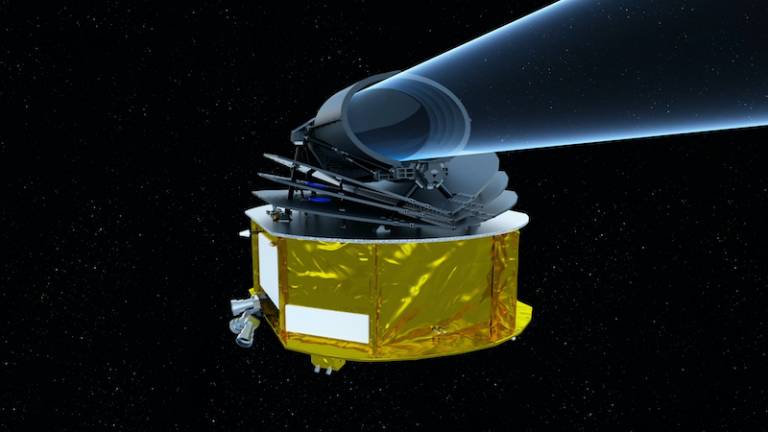ESA formally adopts Ariel, the exoplanet explorer
12 November 2020
The European Space Agency (ESA) have formally adopted Ariel, the first mission dedicated to study the nature, formation and evolution of exoplanets. We extend our warmest congratulations to CPS colleague and Ariel PI, Prof Giovanna Tinetti, and to the Ariel Team!

Ariel (Atmospheric Remote-Sensing Infrared Exoplanet Large-survey) scheduled for launch in 2029, will survey about 1000 planets outside our solar system during its lifetime. It aims to unveil the nature, formation and evolution of a large and assorted sample of planets around different types of stars in our galaxy.
More than 50 institutes from 17 countries have been working over the past 5 years to develop the science goals and design the instrumentation which will enable Ariel to survey a diverse sample of exoplanets.
The mission has passed a rigorous set of reviews which it has been undergoing throughout 2020 to prove the technical feasibility and science case and has now received approval from ESA’s member states, confirming that the team can work towards the 2029 launch.
Professor Giovanna Tinetti, Principal Investigator for Ariel from University College London said, “We are the first generation capable of studying planets around other stars. Ariel will seize this unique opportunity and reveal the nature and history of hundreds of diverse worlds in our galaxy. We can now embark on the next stage of our work to make this mission a reality."
Ariel will be the first mission dedicated to measuring the chemical composition and atmospheric thermal properties of hundreds of transiting exoplanets. Ariel will give us a picture of a diverse range of exoplanets: from extremely hot to temperate, from gaseous to rocky planets orbiting close to their parent stars.
By looking specifically at hot planets, scientists are expecting to build an understanding of the formation of planets and their evolution. At hotter temperature, which in some cases it can be more than 2000’C, a greater number of exotic molecules will be visible to Ariel. The instruments will then be able to determine what the atmospheres are made up of and provide scientists a unique insight into the planet’s internal composition and the formation history of the planetary system.
The Ariel team is taking a very open approach providing rapid access to data and even encouraging enthusiasts to help select targets and characterise stars. Much of the data willbe available to both the science community and general public immediately.
“Ariel will enable planetary science far beyond the boundaries of our own Solar System,” says Günther Hasinger, ESA’s Director of Science. “The adoption of Ariel cements ESA’s commitment to exoplanet research and will ensure European astronomers are at the forefront of this revolutionary field for the next decade and well beyond.”
Ariel will have a meter-class telescope primary mirror to collect visible and infrared light from distant star systems. An infrared spectrometer will spread the light into a ‘rainbow’ and extract the chemical fingerprints of gases in the planets’ atmospheres, which become embedded in starlight when a planet passes in front or behind the star. A photometer, a spectrometer and guidance system will capture information on the presence on clouds in the atmospheres of the exoplanets and will allow the spacecraft to point to the target star with high stability and precision.
The Ariel Consortium Project Manager, Paul Eccleston, of STFC RAL Space, said “This represents the culmination of lots of preparatory work by our teams across the world over the last 5 years in order to demonstrate the feasibility and readiness of the payload. We now go full speed ahead to fully develop the design and start building prototypes of the instrumentation on the spacecraft.”
The Ariel mission consortium teams from across Europe will now move on to build and prototype their designs for the payload of Ariel and plan for receiving and processing the data. The industrial contractor for the spacecraft bus, which will support the payload coming from the nationally funded consortium teams, will be selected in the summer 2021.
Ariel facts and figures
- Elliptical primary mirror: 1.1 x 0.7 metres
- Instrumentation: 3 photometric channels and 3 spectrometers covering continuously from 0.5 to 7.8 microns in wavelength
- Mission lifetime: at least 4 years in orbit
- Launch date: 2029
- Payload mass: ~500 kg
- Launch mass: ~1500kg
- Destination: Sun – Earth Lagrange Point 2 (L2)
- ESA Mission Cost: ~550 million Euros, plus nationally funded contribution of the payload
- Launch vehicle: Ariane 6-2 from French Guiana shared with Comet Interceptor
Links
- Professor Giovanna Tinetti’s academic profile
- UCL Physics & Astronomy
- Ariel space mission
- ESA announcement
Image
Artist’s impression of Ariel. Image Credit: ESA/STFC RAL Space/UCL/UK Space Agency/ ATG Medialab
 Close
Close

